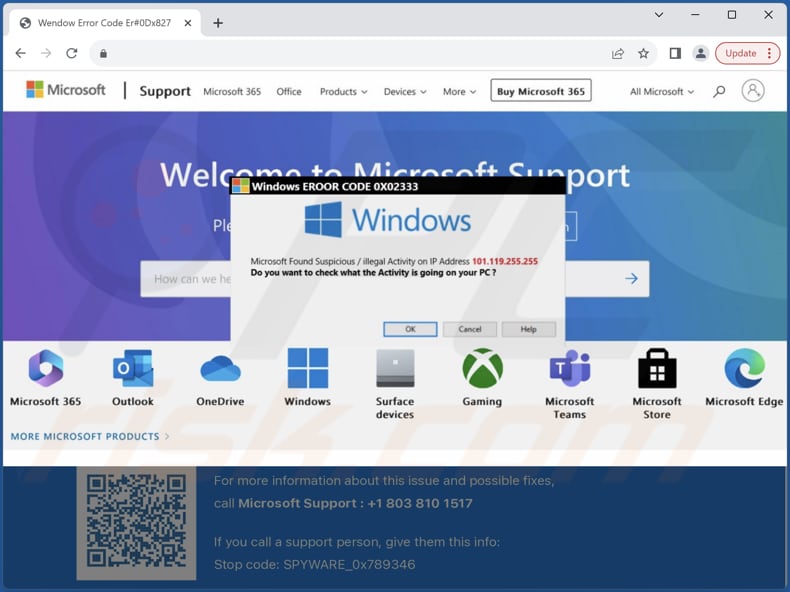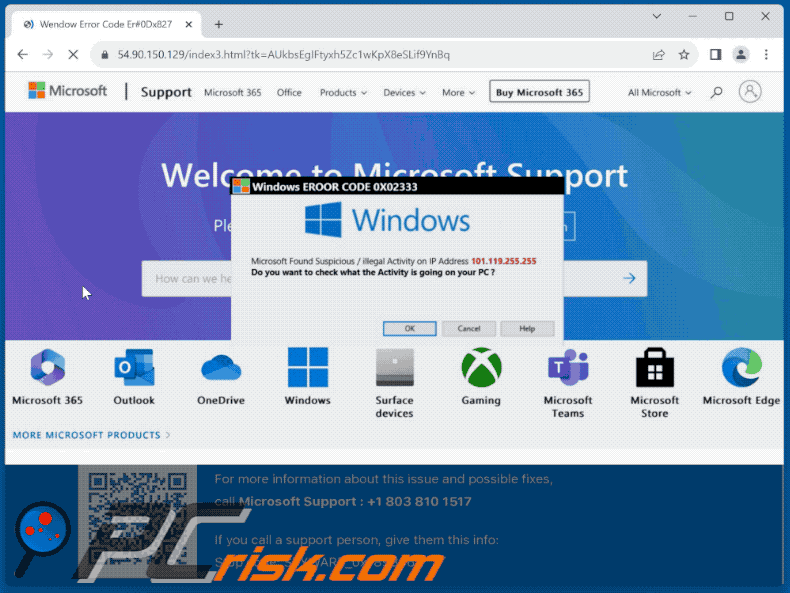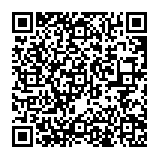How to avoid falling for scams like "Windows EROOR CODE 0X02333"
![]() Written by Tomas Meskauskas on
Written by Tomas Meskauskas on
What is "Windows EROOR CODE 0X02333"?
Upon scrutinizing this scam, we concluded that it follows the typical pattern of a technical support scam designed to deceive unsuspecting visitors into taking specific actions. Typically, scams like these are employed to extract money or information or distribute malware. Consequently, users are strongly urged to refrain from trusting websites of this nature.

"Windows EROOR CODE 0X02333" scam in detail
The scam page presents alarming messages, ostensibly from Microsoft, to create a sense of urgency and panic among visitors. The fraudulent content claims that suspicious or illegal activity has been detected on the user's IP address, leading to the blocking of access to their PC for supposed security reasons.
It falsely asserts that the visitor's personal and banking information is compromised, urging them not to restart their computer. The page provides a phone number, +1 803 810 1517, instructing users to call Microsoft Support immediately to address the purported spyware infection.
Furthermore, the deceptive content warns users that their computer has signaled an infection with spyware, putting various data at risk, including Facebook and email correspondence, credit card details, bank account information, and other confidential files.
The page employs fear tactics, advising against restarting the PC and emphasizing the need to contact technical support urgently to prevent potential data theft or misuse. To lend an air of authenticity, a stop code, SPYWARE_0x789346, is provided for users to convey to the supposed support personnel when calling.
In reality, this is a classic example of a technical support scam, aiming to exploit users by creating a false sense of urgency and coercing them into contacting the fraudulent support number (calling scammers). Users should exercise caution and avoid interacting with such deceptive pages.
Threats posed by technical support scams
Scammers executing technical support scams have multifaceted objectives. One of their key aims is to deceive unsuspecting individuals into paying for unnecessary or entirely fabricated technical support services of software. In other cases, scammers may try to trick users into downloading malicious files or programs.
Also, scammers can try to gain unauthorized access to victims' computers. This can lead to the installation of malware, enabling the theft of personal information, login credentials, and other sensitive data. A couple of examples of scams where remote access software is used to obtain access to computers are the TeamViewer scam and UltraViewer scam.
| Name | Windows EROOR CODE 0X02333 technical support scam |
| Threat Type | Phishing, Scam, Social Engineering, Fraud |
| Fake Claim | A computer is infected and blocked for security reasons |
| Disguise | Warning from Microsoft |
| Tech Support Scammer Phone Number | +1 803 810 1517 |
| Symptoms | Fake error messages, fake system warnings, pop-up errors, hoax computer scan. |
| Distribution methods | Compromised websites, rogue online pop-up ads, potentially unwanted applications. |
| Damage | Loss of sensitive private information, monetary loss, identity theft, possible malware infections. |
| Malware Removal (Windows) | To eliminate possible malware infections, scan your computer with legitimate antivirus software. Our security researchers recommend using Combo Cleaner. |
Similar scams in general
Technical support scams share common traits designed to deceive and manipulate unsuspecting individuals. Typically initiated through alarming pop-up messages or fake websites, these scams employ fear tactics by claiming the victim's computer is infected, compromised, or facing imminent issues.
The scammers often pose as legitimate tech support personnel from reputable companies like Microsoft, urging users to take immediate action to resolve non-existent problems. As a rule, these scams direct victims to call a provided phone number.
Overall, these scams exploit users' trust, create a sense of urgency, and aim to extract money or sensitive information or gain remote access to computers. Examples of technical support scams are "Virus/Malware Infections Have Been Recognized", "Ransomware EXE.01092-1_Alert", and "Trojan:Slocker".
How did I open a scam website?
Users might encounter scam websites through malicious advertisements or pop-ups (including notifications from dubious pages) that appear while browsing. Also, users may be redirected to scam websites through compromised or malicious links shared on social media platforms or other online forums.
In other cases, users land on scam sites via pages that use rogue advertising networks (e.g., most torrent sites or illegal movie streaming pages) or advertising-supported apps. In any case, users open scam websites unintentionally.
How to avoid visiting scam pages?
Be wary of unsolicited emails or messages, especially those containing urgent requests or unfamiliar links. Refrain from clicking on pop-up ads or banners that appear suspicious, and be cautious when following links shared on social media or online forums. Do not visit pages hosting illegal (e.g., pirated) content.
Avoid downloading apps from unreliable sources like unofficial pages and third-party stores. Do not agree to receive notifications from shady websites. Use reputable antivirus software and keep all installed programs (including the operating system) up to date. If your computer is already infected with unwanted apps, we recommend running a scan with Combo Cleaner Antivirus for Windows to automatically eliminate them.
The appearance of "Windows EROOR CODE 0X02333" pop-up scam (GIF):

Text in this scam:
Initial pop-up:
Windows EROOR CODE 0X02333
Windows
Microsoft found suspicious / illegal activity on IP address -
Do you want to check what the Activity is going on your PC?
Second scam window:
Access to this PC has been blocked for security reasons Please do not restart your PC
Your Personal & Banking information is compromised
Contact Support
:(Your Windows PC has been infected
*Do not restart your PC Call Microsoft Support : +1 803 810 1517
Your computer has warned us that it is infected with a spyware. The following data is at risk :
Facebook and email correspondence.
Credit card, bank account and document data as well as other confidential information.
Files on this computer.
Microsoft strongly recommends to contact Technical Support, do not restart your PC otherwise we cannot guarantee that your personal data will not be stolen or misused.For more information about this issue and possible fixes, call Microsoft Support :
If you call a support person, give them this info:
Stop code: SPYWARE_0x789346
Instant automatic malware removal:
Manual threat removal might be a lengthy and complicated process that requires advanced IT skills. Combo Cleaner is a professional automatic malware removal tool that is recommended to get rid of malware. Download it by clicking the button below:
▼ DOWNLOAD Combo Cleaner
By downloading any software listed on this website you agree to our Privacy Policy and Terms of Use. To use full-featured product, you have to purchase a license for Combo Cleaner. 7 days free trial available. Combo Cleaner is owned and operated by Rcs Lt, the parent company of PCRisk.com read more.
Quick menu:
- What is Windows EROOR CODE 0X02333 technical support scam?
- How to identify a pop-up scam?
- How do pop-up scams work?
- How to remove fake pop-ups?
- How to prevent fake pop-ups?
- What to do if you fell for a pop-up scam?
How to identify a pop-up scam?
Pop-up windows with various fake messages are a common type of lures cybercriminals use. They collect sensitive personal data, trick Internet users into calling fake tech support numbers, subscribe to useless online services, invest in shady cryptocurrency schemes, etc.
While in the majority of cases these pop-ups don't infect users' devices with malware, they can cause direct monetary loss or could result in identity theft.
Cybercriminals strive to create their rogue pop-up windows to look trustworthy, however, scams typically have the following characteristics:
- Spelling mistakes and non-professional images - Closely inspect the information displayed in a pop-up. Spelling mistakes and unprofessional images could be a sign of a scam.
- Sense of urgency - Countdown timer with a couple of minutes on it, asking you to enter your personal information or subscribe to some online service.
- Statements that you won something - If you haven't participated in a lottery, online competition, etc., and you see a pop-up window stating that you won.
- Computer or mobile device scan - A pop-up window that scans your device and informs of detected issues - is undoubtedly a scam; webpages cannot perform such actions.
- Exclusivity - Pop-up windows stating that only you are given secret access to a financial scheme that can quickly make you rich.
Example of a pop-up scam:

How do pop-up scams work?
Cybercriminals and deceptive marketers usually use various advertising networks, search engine poisoning techniques, and shady websites to generate traffic to their pop-ups. Users land on their online lures after clicking on fake download buttons, using a torrent website, or simply clicking on an Internet search engine result.
Based on users' location and device information, they are presented with a scam pop-up. Lures presented in such pop-ups range from get-rich-quick schemes to fake virus scans.
How to remove fake pop-ups?
In most cases, pop-up scams do not infect users' devices with malware. If you encountered a scam pop-up, simply closing it should be enough. In some cases scam, pop-ups may be hard to close; in such cases - close your Internet browser and restart it.
In extremely rare cases, you might need to reset your Internet browser. For this, use our instructions explaining how to reset Internet browser settings.
How to prevent fake pop-ups?
To prevent seeing pop-up scams, you should visit only reputable websites. Torrent, Crack, free online movie streaming, YouTube video download, and other websites of similar reputation commonly redirect Internet users to pop-up scams.
To minimize the risk of encountering pop-up scams, you should keep your Internet browsers up-to-date and use reputable anti-malware application. For this purpose, we recommend Combo Cleaner Antivirus for Windows.
What to do if you fell for a pop-up scam?
This depends on the type of scam that you fell for. Most commonly, pop-up scams try to trick users into sending money, giving away personal information, or giving access to one's device.
- If you sent money to scammers: You should contact your financial institution and explain that you were scammed. If informed promptly, there's a chance to get your money back.
- If you gave away your personal information: You should change your passwords and enable two-factor authentication in all online services that you use. Visit Federal Trade Commission to report identity theft and get personalized recovery steps.
- If you let scammers connect to your device: You should scan your computer with reputable anti-malware (we recommend Combo Cleaner Antivirus for Windows) - cyber criminals could have planted trojans, keyloggers, and other malware, don't use your computer until removing possible threats.
- Help other Internet users: report Internet scams to Federal Trade Commission.
Frequently Asked Questions (FAQ)
What is a pop-up scam?
A pop-up scam is a deceptive tactic where fraudulent pop-up windows or messages appear on a user's screen, often while browsing the internet. These pop-ups typically contain misleading information, false warnings about computer issues, or prompts to click on malicious links.
What is the purpose of a pop-up scam?
The goal is to trick users into taking actions that benefit the scammer, such as providing personal information, downloading malware, or paying for fake services.
Why do I encounter fake pop-ups?
Typically, users encounter fake pop-ups while visiting unreliable pages that use rogue advertising networks, such as illegal movie streaming pages, torrent sites, and similar websites. Also, these pop-ups may appear from installed adware or similar software. Notifications from dubious websites can also contain fake messages.
Will Combo Cleaner protect me from pop-up scams?
Combo Cleaner can inspect each website you visit, effectively identifying and flagging any potentially malicious sites. This includes websites that are crafted to deploy pop-up scams. Consequently, Combo Cleaner will promptly alert you and restrict access if you encounter such a site.


▼ Show Discussion